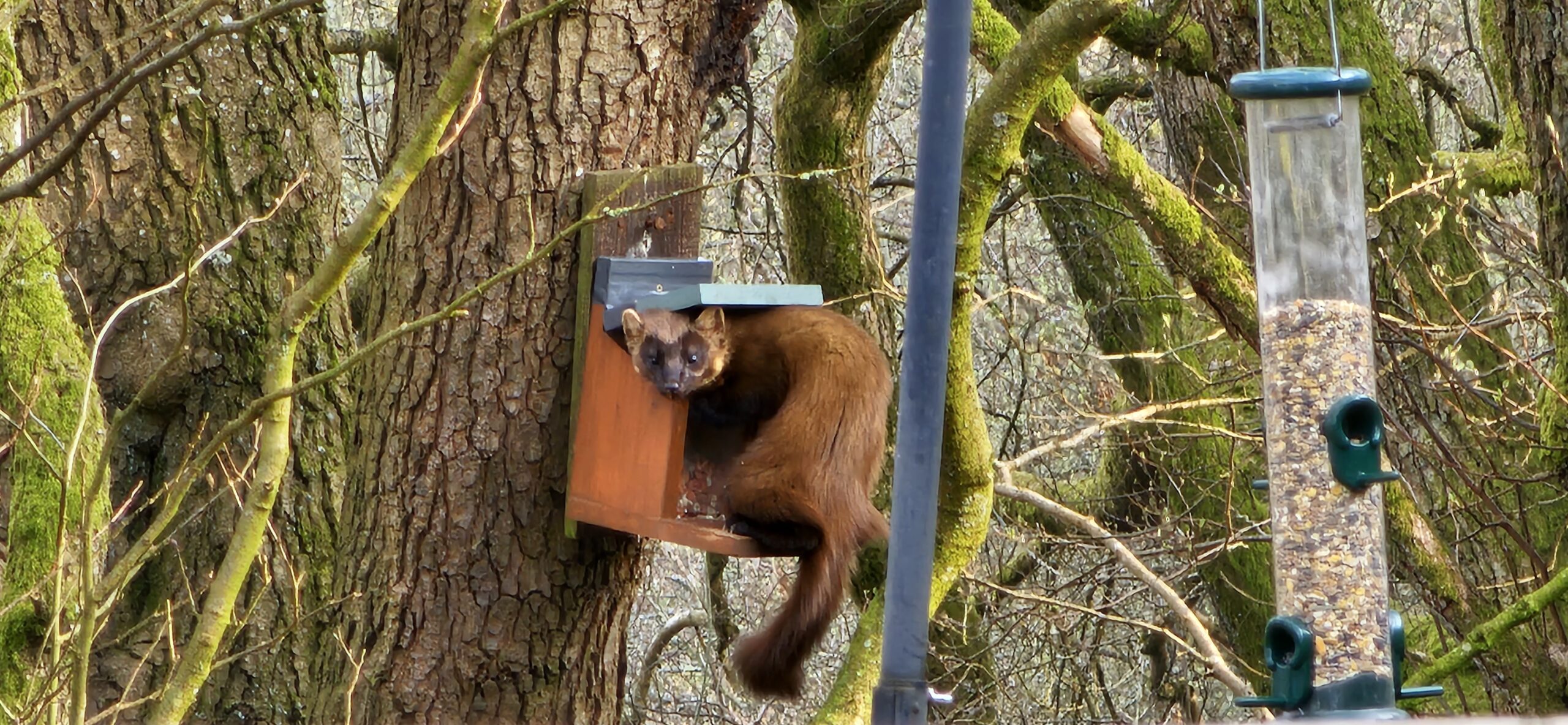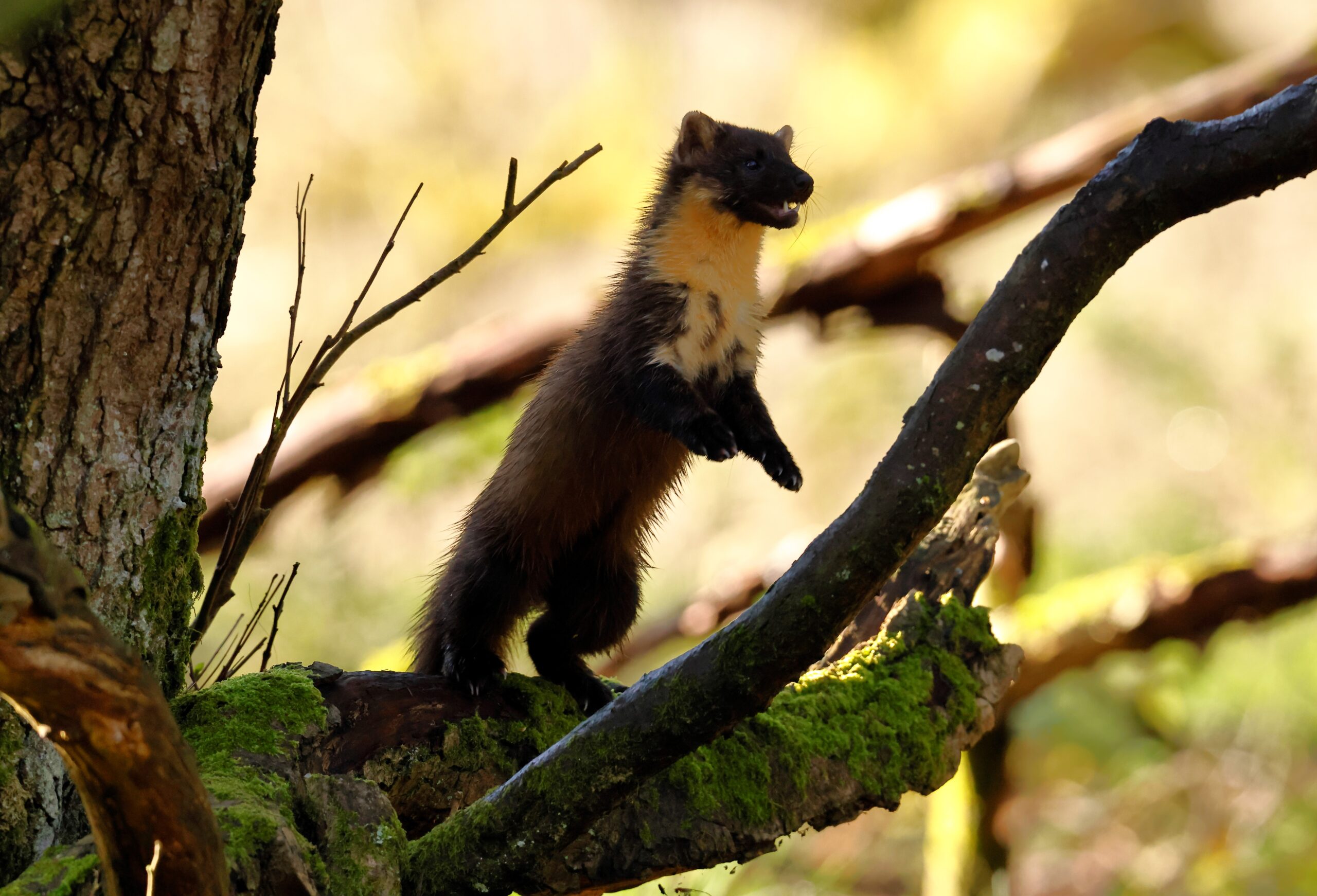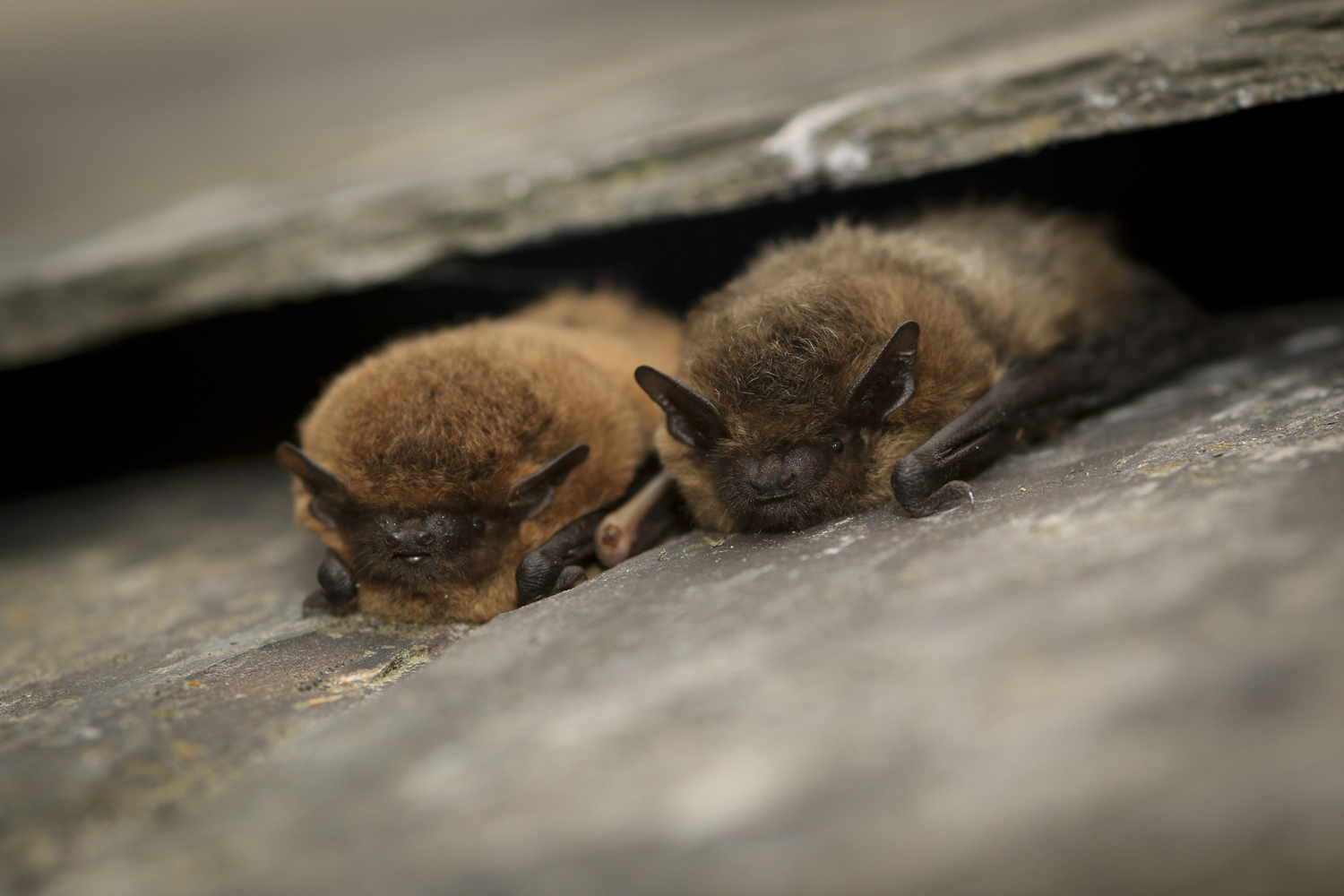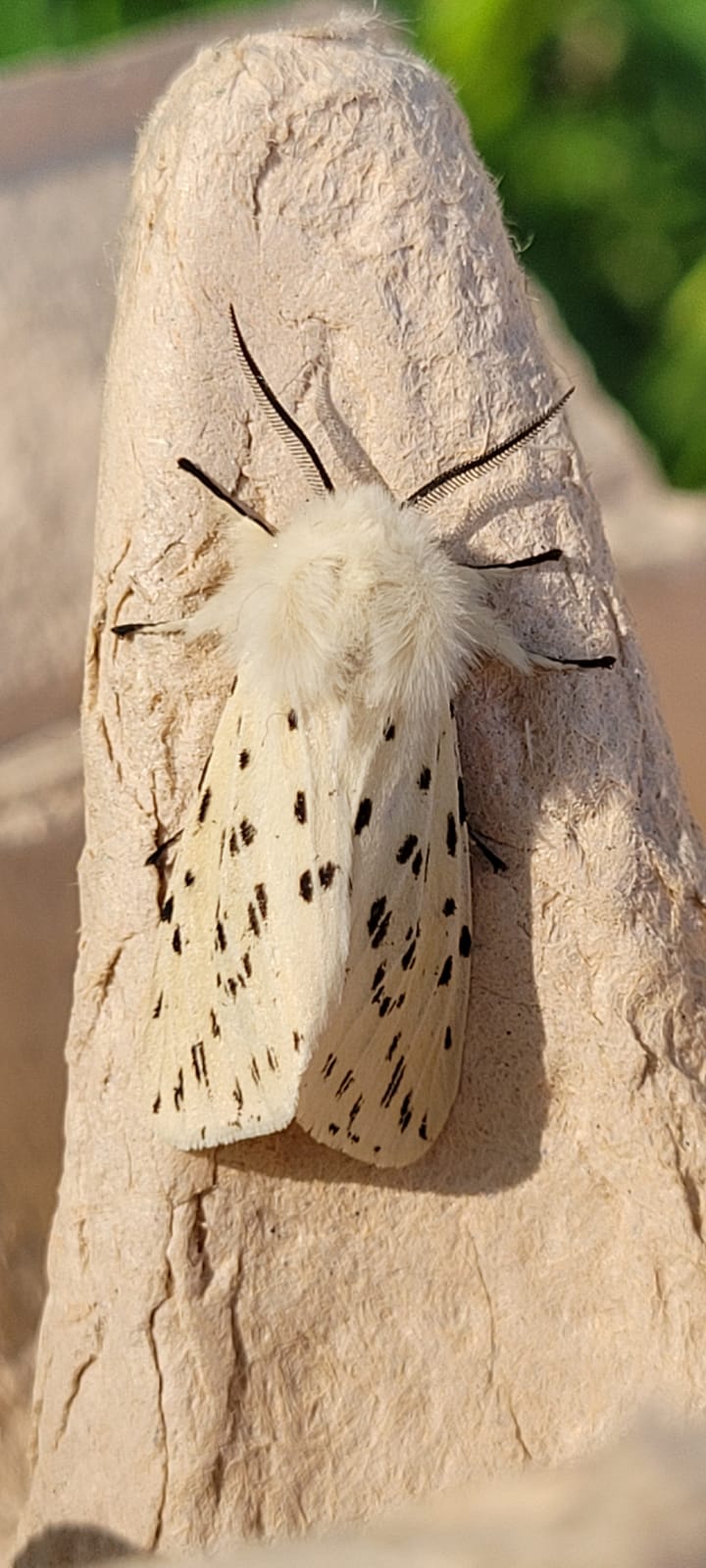Nightlife at Loch of the Lowes
At Loch of the Lowes the breeding osprey pair have been the centre of attention since their arrival in mid-March. However, Loch of the Lowes is a haven for a multitude of other wildlife from owls, pine martens, frogs, otters, bats, and many more. Our 24 hour Osprey Watch allows the Species Protection Officers to witness the wonders of nocturnal life on the live trail cameras situated around the reserve.
Read on to discover what the team captured during their night shifts.
Pine Martens
Most evenings pine marten have been observed at the red squirrel feeders, although they have also been spotted out during the day. The staff and volunteers refer to the various visitors fondly as ‘Martini the pine marten’ – just to cover any male and female individuals that may be in the area. We think the ‘pinie’ captured below is a male. This cheeky chap likes to throw the metal grate from the red squirrel feeder onto the ground to begin his nightly feast.
We are quite certain that this pine marten is a regular visitor. All pine martens have a uniquely shaped light patch on their chest, or ‘bib’. The patterning on the front of his chest displays a brown streak on the right hand side which identifies him from other individuals at night. During the day however, he is easily distinguishable from others as he has a dark brown mask on his face, as was captured by a visitor a few weeks ago.

Pine martens have been seen multiple times during the day here at Lowes despite being predominantly nocturnal, however, during the summer months it is perfectly normal to see pine martens during the day. Perhaps Martini likes a midnight or rather, midday snack.
More recently we have seen another much smaller individual pine marten, which could suggest we have a female or juvenile on the reserve, as males are around 30% larger than females. Pine martens are extremely territorial and the males can travel up to 25 kilometers to feed often out-competing other pine marten, including juveniles, pushing them to find territories of their own.
This photo was captured by a visitor just next to the viewing window at Loch of the Lowes Visitor Centre. Notice the very different patterning on her bib.

Beavers
Beavers can be sighted on a daily basis at dawn and dusk around the reserve, this is known as crepuscular activity. They are herbivorous (that is they only eat plant material) and are an important keystone species in our freshwater environments in the UK. Here at Loch of the Lowes we regularly see beavers at dawn and dusk from our hides, on their way travelling back and forth to munch on some nearby vegetation. If you are an early bird (or night owl) you can access our hides around the clock, to try and catch a sighting of them swimming across the loch or feeding on the water lilies, bracken and bogbean. You can also join us for a guided ‘Beaver Breakfast’ or one of our many ‘Beaver Watch’ evenings running throughout the summer.
We recently observed a beaver behaviour known as ‘scent marking’. This is when a beaver will deposit a scent from their anal glands onto piles of mud or prominent positions on the banks. This marks out the boundaries of their territory and leaves a warning to other beavers who may stray onto their patch that they are not welcome. Beavers will often only scent mark in areas that are good quality, or when they have occupied the territory for a long period of time. It seems as though Loch of the Lowes has been given the ‘scent of approval’ from the resident family.
Otters
We do have at least two otters here at Loch of the Lowes which have regularly been observed in the canal on our trail camera. Whilst few have caught a glimpse in person, one otter was spotted from the hide swimming at 5:30am.
Otters are not usually fond of people and are mostly nocturnal. Otters are also well-known as predators of young beaver kits. Territorial stand offs between otters and beavers are also common, both as a consequence of beavers defending vulnerable kits, but also chasing otters away from suitable real estate. Otter holts and beaver bank lodges can be similar in their construction initially, and this can lead to competition between the two species. Indeed both beaver and otter have been observed using a small bank lodge on the reserve.
The following ‘gnaw-rly’ altercation was observed on a trial camera between an otter and beaver over territory. Despite an otters impressive agility, this beaver appears to intimidate the otter with its impressive size and persistent presence. An otter-ly interesting watch.
Two otters have been seen together recently on our canal camera. Otters are mostly solitary, so if two or more are seen together they are usually a female with her cubs. The female will raise them alone for one year, before casting the youngster out to find its own territory and to begin breeding at the age of two.
Owls
A male tawny owl has been regularly seen on the red squirrel feeder. Tawny owls are often heard on our osprey camera calling at night, especially earlier in the breeding season. Tawny owls are famous for their ‘twit- twoo’, however, did you know this calling is a call and response between two tawny mates? The female tawny owl makes a too-wit noise (or ‘ke-wick’), and the male often answers with a wavering ‘hoo-hoo’ sound, which can be heard at all times of the night as they call to their mates.

We also have resident barn owl, which can be identified by their screeching call and ghostly pale appearance. Barn owl having been spotted both on the osprey nest and swooping along the canal. Like tawnys, barn owls have a diet consisting of small rodents such as voles, shrews, mice and even rats. A fun fact about owls is that their ears are lop sided, which increases the accuracy of locating where their prey is hiding.
Bats
There are many species of bats at Loch of the Lowes including as daubentons, brown long eared bats, soprano pipistrelles and common pipistrelles. It is a great time to spot bats over water bodies such as Loch of the Lowes and the nearby River Tay. The long summer days are perfect for hatching insects, and daubenton bats in particular can be spotted acrobatically flying at dusk as they swoop and dive to catch mayflies. Come along to Loch of the Lowes at dusk for a chance to see them for yourself.

It is a common misconception that bats are blind, this is not the case. Indeed it is thought that bats’ eyesight is better than humans. Their sensitive eyesight, is used in conjunction with echolocation to navigate in and out of roosts and to catch prey, particularly in low level light. Since they predominantly hunt at night and in pitch black conditions, echolocation helps them pinpoint prey. The bats release a series of ultrasonic pulses, often called a feeding buzz, that reverberate back to their ears, allowing them to analyse their surroundings and fly in complete darkness.
Moths
During our stay the Species Protection Team set up a moth trap to gain insight into the types of moths found at Loch of the Lowes. As moths are nocturnal it can sometimes be difficult to see how detailed and beautiful they are, however taking time to observe and photograph moths opens up a whole world of subtle and beautiful patterns and markings – not to mention fantastic names!
Although it was quite cold and early in the season when the team ran the trap, we did manage to identify a white ermine (pictured), a peppered moth and a gypsy moth. The white ermine moth has impressive antennae which moths use for a variety of purposes. The antennae are used to find potential mates, but also locate the scent of their favoured food, or nectar in the air. Antennae are also used to help moths balance whilst flying.
Come along to our ‘Moth Night’ later in the season to find out more about these fascinating creatures.

We hope you have enjoyed learning about some of the nocturnal wildlife that is active each night on the reserve. The following compilation captures and further explores the nocturnal life discussed in the blog.
Alexandra Jackson
Species Protection Officer
The Trust’s Osprey Protection Programme at Loch of the Lowes is supported by players of People’s Postcode Lottery.
References
Countryfilemag, Pine Marten Guide: How to identify, what they eat and where to see in Britain, Pine marten guide: how to identify, what they eat and where to see in Britain | Countryfile.com. Available at: https://www.countryfile.com/wildlife/mammals/pine-marten-guide-how-to-identify-where-to-see-in-britain-and-other-facts/ (Accessed: 14 May 2023).
Otter (Eurasian) (2014) Young People’s Trust For the Environment. Available at: https://ypte.org.uk/factsheets/otter-eurasian/breeding (Accessed: 15 May 2023).
Rosell, F., Bergan, F. and Parker, H., 1998. Scent-marking in the Eurasian beaver (Castor fiber) as a means of territory defense. Journal of Chemical Ecology, 24, pp.207-219.
Salles, A., 2022. Bats: Vision or echolocation, why not both?. Current Biology, 32(7), pp.R318-R320.
Tawny owl (no date) The Wildlife Trusts. Available at: https://www.wildlifetrusts.org/wildlife-explorer/birds/birds-prey/tawny-owl (Accessed: 15 May 2023)
Help protect Scotland’s wildlife
Our work to save Scotland’s wildlife is made possible thanks to the generosity of our members and supporters.
Join today from just £4 a month to help protect the species you love.
Preface
At Loch of the Lowes the breeding osprey pair have been the centre of attention since their arrival in mid-March. However, Loch of the Lowes is a haven for a …
